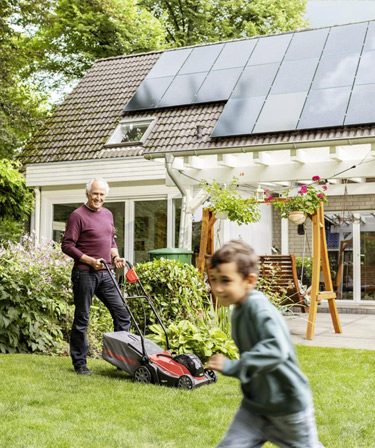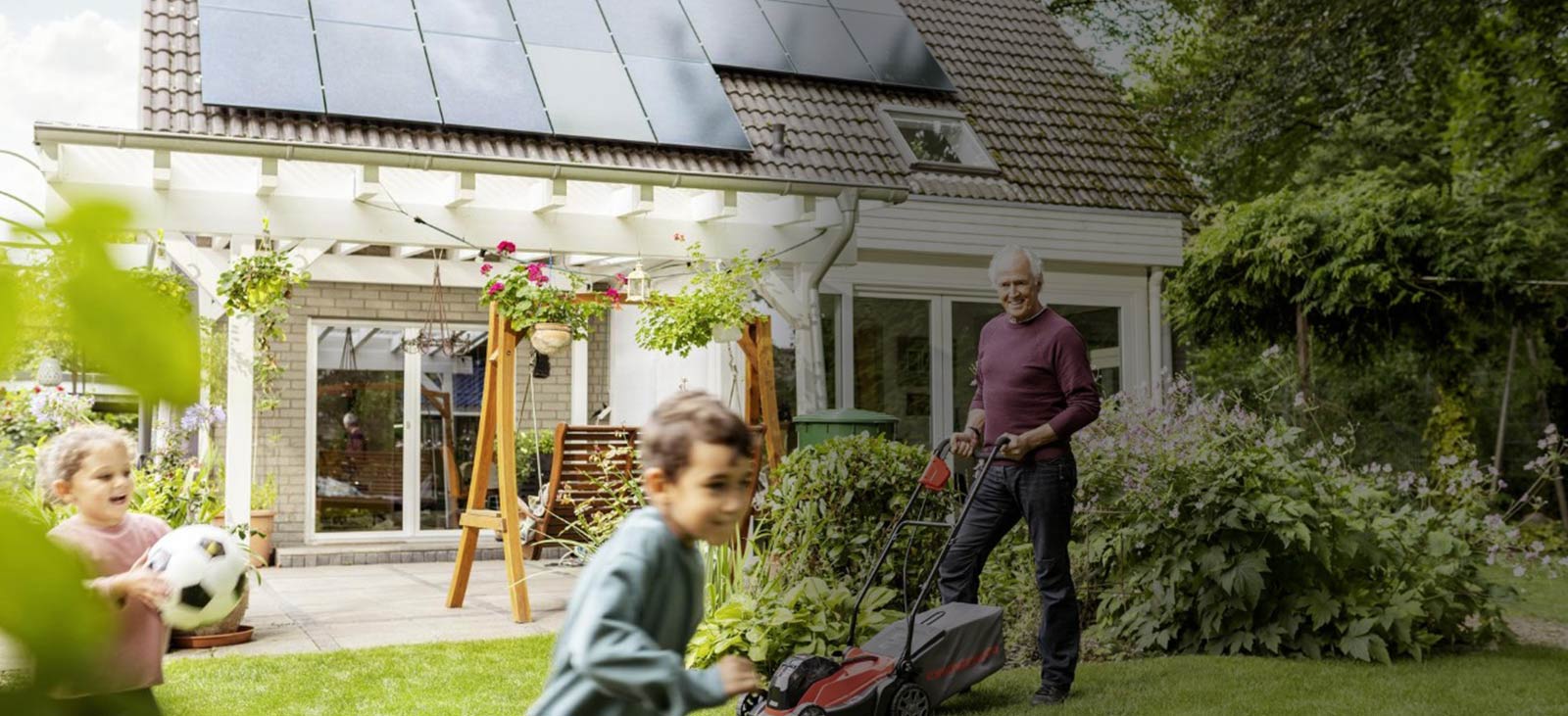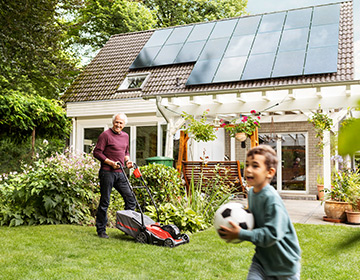Exclusive SEG tariff
A trusted provider
Peace of mind
Battery storage for business
What are E.ON solar batteries made of?
We use lithium iron phosphate (LFP) battery chemistry, which is one of the safest types of lithium ion battery. LFP batteries can do more charge/discharge cycles than other types of solar batteries so have longer lifespans, and also have a lower environmental impact than cobalt-based batteries.
How big are solar batteries?
The typical wall space required for an inverter and battery system is just over one metre in width, and between 1.3m and 1.9m in height, depending on the power and size of the battery. You’ll need somewhere to house the battery and system, and they can be installed in most places such as a garage or utility room.
Where will the solar battery be installed?
We'll conduct a full survey of your home that'll help you to decide on the best location for your battery. It has to be fairly close to your main consumer unit so we have to take that in to account but we normally try to put it in a cupboard, garage, utility room or somewhere similar.
Can I have a solar battery in the loft?
Yes. Unlike older lead-acid batteries, which were too heavy, our lithium-ion batteries are much lighter, and we can lift 2.6 kWh modules into a loft.
We need to have a big enough loft hatch with a fixed ladder in order to be able to safely complete the lift, plus a gable-end brick wall on which to mount the batteries, and ideally the loft should be securely boarded, and offer ample clearance space around the battery for easy installation and maintenance.
Can solar panels work without battery storage?
You don't need to have a battery for your solar PV panels to work. However, energy storage allows you to use more of the eco-friendly energy you generate in your home rather than exporting it back to the grid, which could save you money.
What's the lifespan of a solar battery?
The average lifespan of a solar battery is around ten years, but this can vary depending on the type of battery, the usage, and the maintenance. Our battery systems come with a 10-year manufacturer’s warranty.
Are there any solar grants or schemes available?
The Government currently back an initiative called the Smart Export Guarantee (SEG), allows homeowners to sell their excess electricity to the energy companies. Details of E.ON SEG tariff can be found here.
Additionally, the Energy Company Obligation (ECO) scheme provides funding for energy-efficient home improvements, including the installation of solar batteries.
There a number of grants and funding options available across various locations in the UK. You can use our Grant Finder to see if you are eligible for part funded solar panels.
Can I have a solar battery outside?
Yes, you can. If we can’t find anywhere to fit a battery inside, you can have your solar battery wall-mounted on the outside of your property. However, it shouldn't be in view of direct midday sun, (i.e. not on a south-facing wall) or be exposed to direct rain, and some kind of roof/shelter will be required.
Will my FiT tariff change if I add a solar battery?
You should always check with your Feed-in Tariff (FiT) provider, but when we fit a battery-only system we don't touch the existing solar system; we just fit an “AC-connected” battery system, which monitors the existing solar inverter, but doesn't electrically interact with it. Using this technology, your existing FiT payments shouldn't be affected.
After installing your battery, you may choose to change to a SEG export tariff instead of FiT export.
Do I have to pay VAT on solar panels and solar batteries?
Since the 1st of February 2024, VAT on retrofitted batteries has been removed. So whether a solar battery is fitted at the same time as solar panels, or supplied as a standalone installation, you'll pay no VAT (20%).
Will my solar battery still work if there's a power cut?
Our battery systems have an “Emergency Power Supply” (EPS) capability, but connecting this up is unfortunately outside of our scope of supply, as it requires major electrical works to reconfigure your household electrics, and also requires provision of a separate earth (normally one or more earth rods need to be driven into the ground near your property).
You may find other qualified local electricians to complete this work for you after we’ve installed your solar panels.
Once EPS is installed and configured, then in the event of a power cut, your battery system can run in ‘island mode’, and it can supply energy from your battery into your property, and the battery can also be recharged from solar.
What size solar battery is right for me?
Our online battery calculator will recommend a suitable battery for your home, and of course you can discuss this in detail with one of our experts before going ahead with any installation.
Two factors to consider are:
- Do you have sufficient excess solar generation in order to charge the battery each day, across most of the year?
- Do you have sufficient consumption to make use of a fully-charged battery every night?
I already have a solar battery installed, can I get more storage?
As of June 2023, we only supply GivEnergy battery systems, so we can only add more storage to an existing GivEnergy system.
If you have an existing battery system from another manufacturer then we can fit a full, new GivEnergy system (AC-connected inverter and battery modules) to expand your storage capacity, but we can’t supply additional battery modules from other manufacturers.
You can still talk to us about your options, though, if you have any questions.
What is the 'depth of discharge' and 'usable capacity'?
"Depth of discharge" - is the proportion of the battery's nominal capacity available to use e.g. a battery may have a nominal value of 5kWh but if the Depth of Discharge is 80% then the amount charge that can actually be used is only 4kWh.
“Usable Capacity” - is the number of kilowatt-hours (kWh) of energy that a fully charged battery will provide before the battery management system stops any more charge being taken. This is measured as the number of kilowatt-hours to charge the battery so the amount of energy actually available for you to use in your home is typically about 95% of this value, because of small efficiency losses as the battery is charged and discharged.





